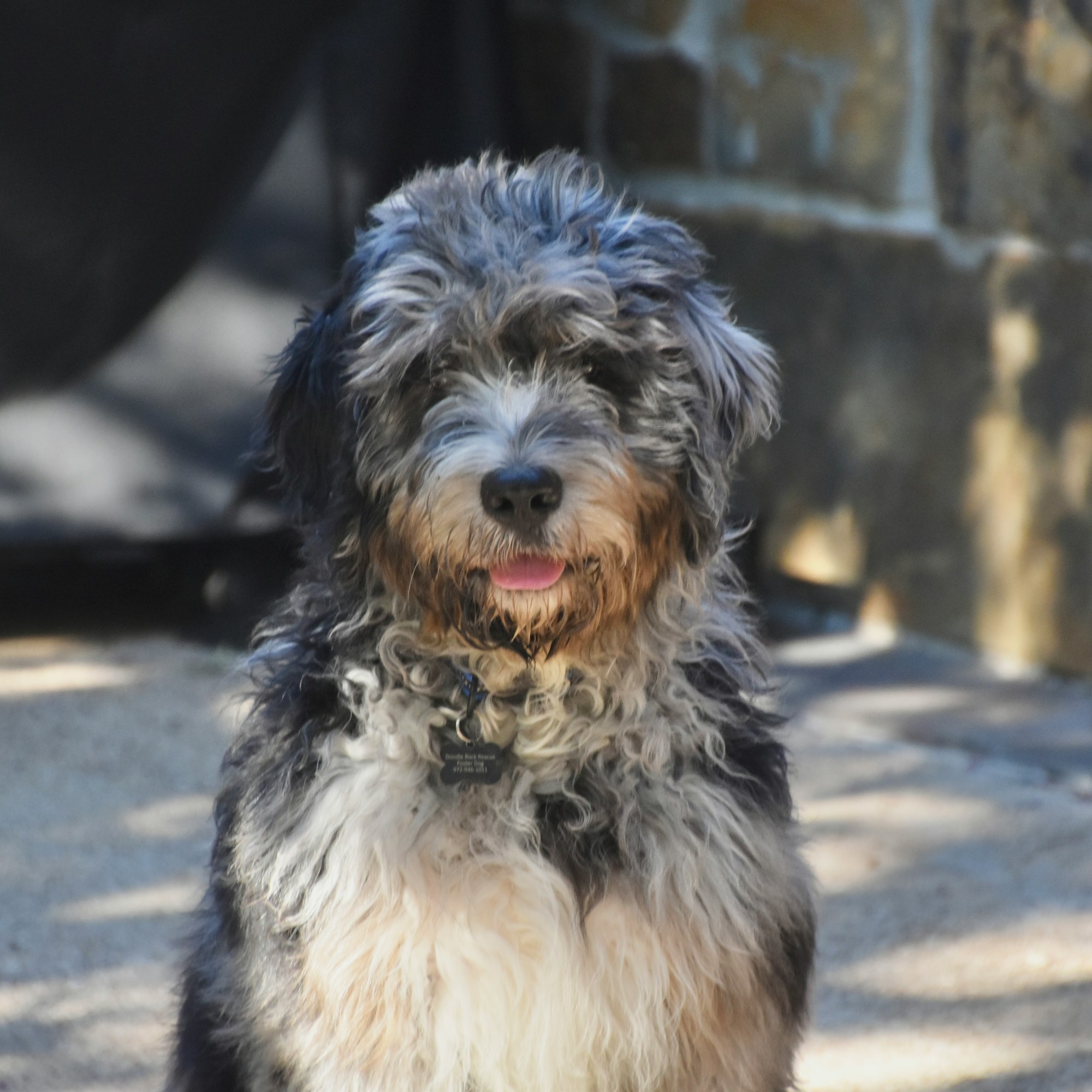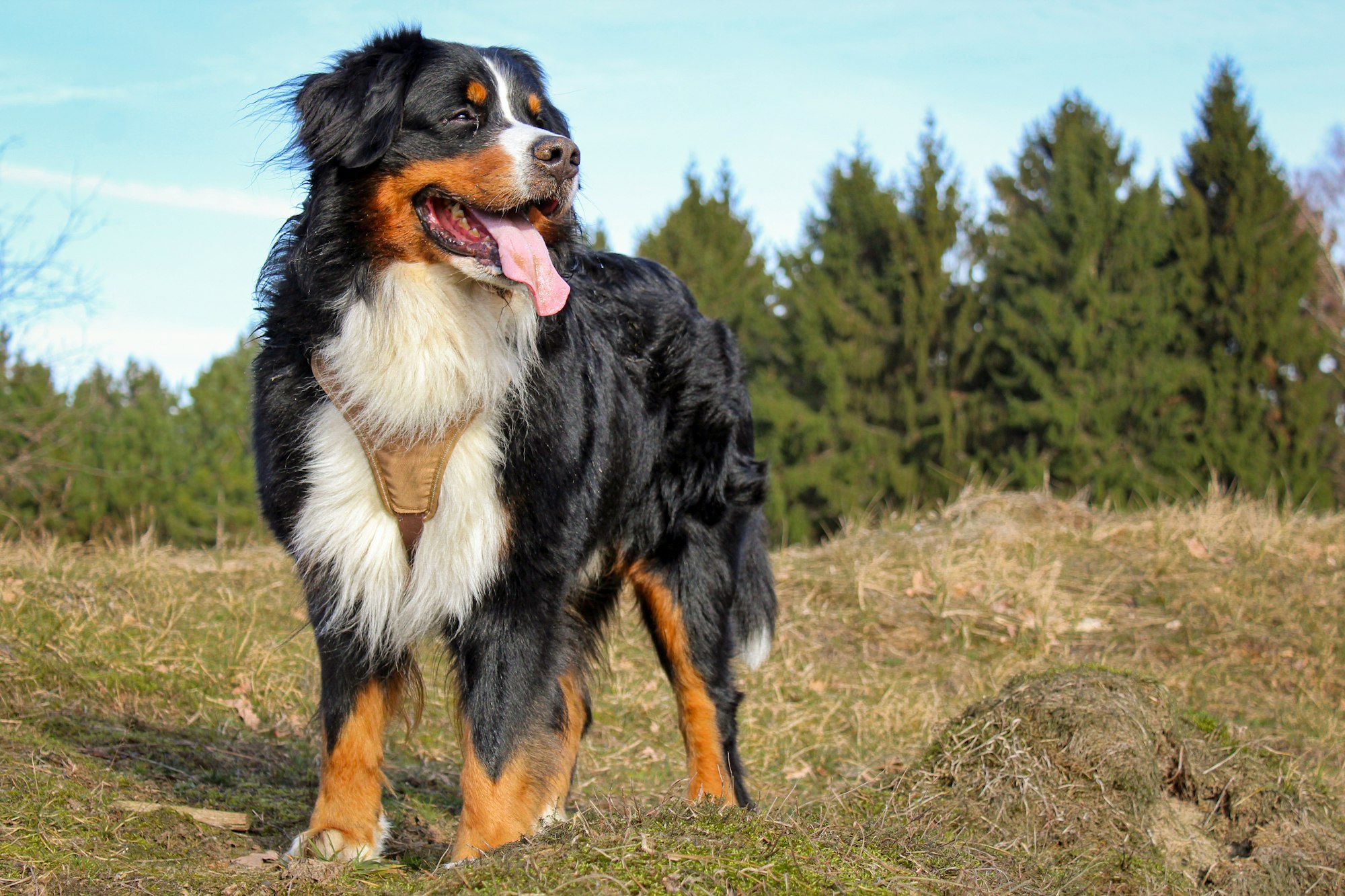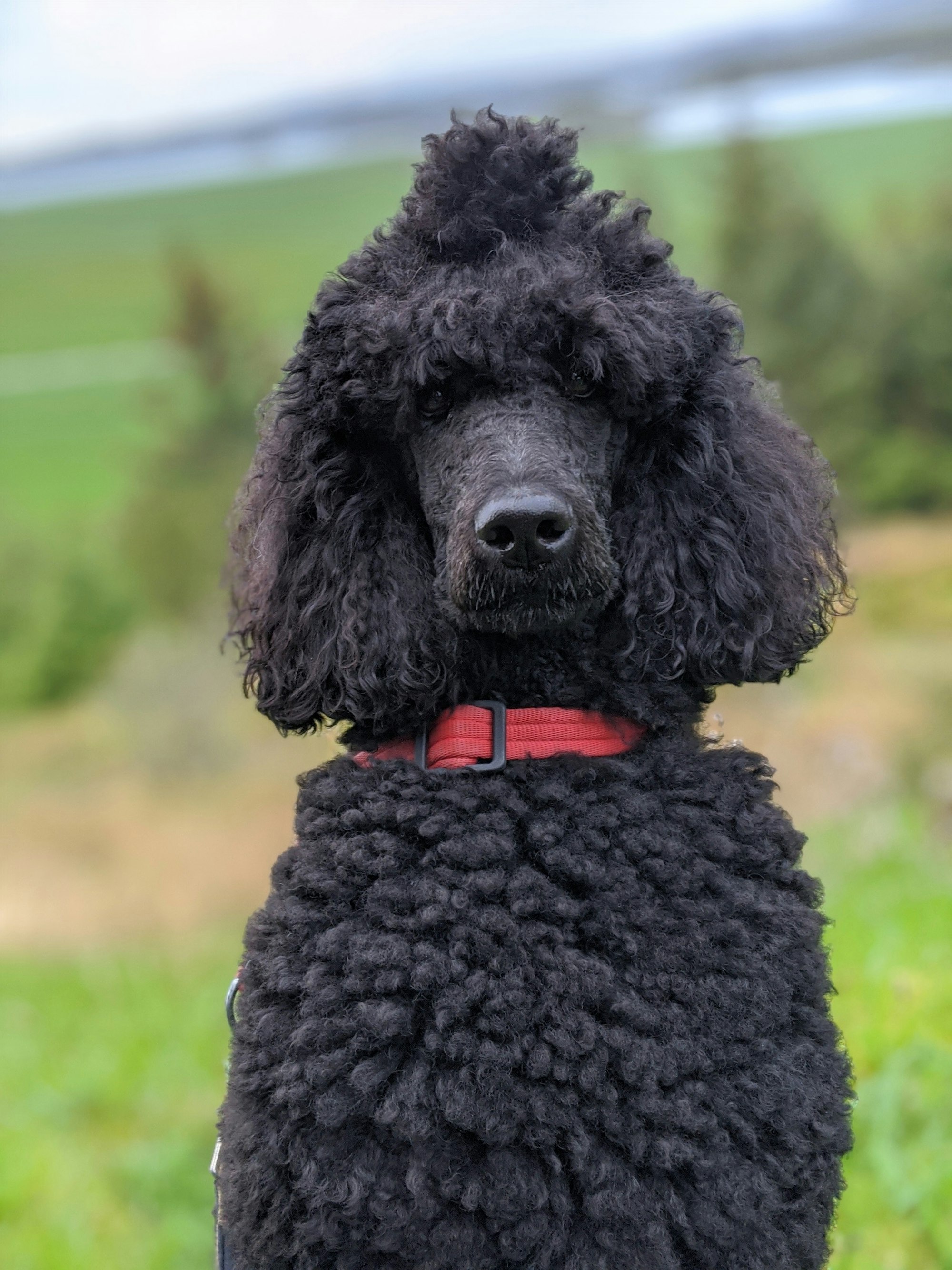The Bernedoodle is a hybrid dog that combines the intelligence and of the Poodle with the robust and loyal personality of the Bernese Mountain Dog. Bernedoodles are also known for having low-shedding coats, which makes them a good choice for people with allergies or who prefer a breed that doesn't shed excessively.
If you are curious about the size of a full grown Bernedoodle, read on as we break them all down.
Elevate Your Bernedoodle's Safety with the Fi Dog Collar
As you embrace the joys of owning a Bernedoodle, a hybrid known for its intelligence, loyalty, and playful spirit, it's crucial to ensure their safety and well-being. The Fi Dog Collar offers cutting-edge technology to complement your pet's adventurous nature. With its GPS tracking feature, you can monitor your Bernedoodle's location in real time, giving you peace of mind and helping you act swiftly if they wander off.
The activity monitoring feature keeps you informed about your dog's fitness levels, supporting a healthy lifestyle for this energetic breed. Plus, with its geofencing capabilities, you'll receive instant alerts if your furry friend strays beyond designated safe zones. Invest in the Fi Dog Collar to secure your Bernedoodle's safety and well-being, allowing you to focus on the joys of pet ownership without the worry of losing sight of your beloved companion. Visit TryFi.com to learn more and give the Fi Dog Collar a try today!
Size Categories of a Full Grown Bernedoodles
1. Standard Bernedoodle Size
Standard Bernedoodles vary in size, with some being larger or smaller than others. However, on average, a full-grown standard Bernedoodle weighs between 50 and 90 pounds and stands 22 to 29 inches. This size range is considered to be a standard or medium Bernedoodle.
It's crucial to note that the size of a standard Bernedoodle can vary depending on the size of the Poodle and Bernese Mountain Dog parents used in the crossbreeding process. For example, suppose a toy poodle is used as one of the parents. In that case, the resulting Bernedoodle puppies may be smaller than a standard Poodle.
Similarly, suppose a standard Bernese Mountain Dog is used as one of the parents. In that case, the resulting Bernedoodle puppies may be larger than if a smaller Poodle was used.
Features of a Full Grown Standard Bernedoodle
- These are energetic and active dogs that need frequent training and psychological stimulation.
- This dog is highly intelligent and can be coached to execute several tasks, such as discipline and swiftness courses.
A standard full grown Bernedoodle can live a long time with its owner with appropriate monitoring and training.
2. Mini Bernedoodle Size
The mini Bernedoodle size is a smaller version of the standard Bernedoodle breed. Similar to standard Bernedoodles, mini Bernedoodles are hybrid dogs that carry the characteristics of the Poodle and the Bernese Mountain Dog.
However, a full grown mini Bernedoodle size is smaller than their bigger sized kinds. On average, the mini Bernedoodle size will often be between 20 and 50 pounds and stand 14 to 22 inches high. This can be considered a medium sized dog.
Additionally, the full size mini Bernedoodle size depends on the parents involved in the breeding process. Mini Bernedoodles are routinely created by breeding a moyan poodle or a mini poodle with a Bernese Mountain Dog.
This crossbreeding procedure results in smaller Bernedoodle puppies that are more active and easily managed in tinier living spaces or for owners with less time for exercise.

Features of a mini Bernedoodle
- Despite their relatively smaller size, mini Bernedoodles are still energetic and active dogs that require frequent training and mental stimulation.
- Mini Bernedoodles are intelligent dogs and can be coached to perform various duties, such as obedience training and agility courses.
- Similar to their full-grown kinds, mini Bernedoodles can make good therapy dogs and provide great companions for families with children.
With proper care and training, mini Bernedoodles can live long, healthy lives with their owners.
3. Toy Bernedoodle Size
The toy Bernedoodle is the smallest variant within the Bernedoodle breed, known for its compact size and charming appearance. Like other Bernedoodles, toy Bernedoodles are a crossbreed of the Poodle and the Bernese Mountain Dog, combining the best traits of both breeds. However, toy Bernedoodles are notably smaller than their full-sized and mini counterparts.
On average, a toy Bernedoodle weighs between 10 and 20 pounds and stands 10 to 14 inches tall at the shoulder. This size makes them ideal for apartment living and for those seeking a smaller, more manageable companion. The Bernedoodle Guide highlights that the size of a toy Bernedoodle can vary depending on the size of the parent dogs used in the breeding process.
Typically, toy Bernedoodles are bred by crossing a tiny or toy Poodle with a small Bernese Mountain Dog. This intentional crossbreeding results in even smaller Bernedoodle puppies, offering a more compact version of the breed. According to the American Kennel Club (AKC), this breeding strategy helps maintain the breed’s desirable traits while catering to those who prefer a smaller dog.
For more information on the Bernedoodle breed and its sizes, the Bernese Mountain Dog Club of America and the Poodle Club of America provide detailed insights and resources on breed standards and characteristics.
Characteristics of Toy Bernedoodles
- Toy Bernedoodles appear to be the smallest of their kind but are still strong dogs and require steady coaching and psychological stimulation.
- Comparing them to their other kinds, these dogs are sharp intellectually. They can be instructed to carry out several duties, such as obedience monitoring and agility teachings.
- Toy Bernedoodles are also regarded to be exemplary therapy dogs and can live longer under good care and training.
Limitations of Toy Bernedoodles
It is important to remember that toy Bernedoodles are more prone to particular health issues due to their small size. These issues may include dental problems, respiratory issues, and joint problems.
Toy Bernedoodle owners should note these potential health issues and work closely with their veterinarian to ensure that their dog receives appropriate care and medical attention.

However, these dogs need regular grooming to maintain their healthy coat. This routine may include frequent brushing, baths, nail trimmings, and ear cleanings. Additionally, the Bernedoodles breed is often used as service and therapy dogs due to their calm and gentle nature.
The Bernadoodle dog breed is among the most juvenile, dating back to the early 2000s. This calm and easy-going dog goes by other names, such as Bernesedoodle, Bernese Mountain Dog, or the Bernepoo mix.
This breed of dog comes in various sizes, including standard Bernedoodles, mini Bernedoodles, and toy Bernedoodles, and can have a wide range of colors in their coat.
To understand the Bernedoodle, you must know a bit about the parent breeds - The Bernese Mountain Dog and The Poodle.
Bernese Mountain Dogs

The Purebred Bernese Mountain Dog is a large, working breed that originated in Switzerland. They were originally used as farm dogs, where they performed tasks such as pulling carts and guarding livestock. The breed gets its name from the canton of Bern, where they were originally developed.
It was recognized as a breed by the Swiss Kennel Club in 1907, and the breed was first imported to the United States in 1926. In 1937, the Bernese Mountain Dog Club of America was formed, and the breed was recognized by the American Kennel Club in 1937.
Today, they are still used for work on farms in some parts of the world, but they are also popular as family pets. They are known for their intelligence, strength, and versatility, and they are often used in search and rescue, therapy, and as guide dogs. They are also shown in conformation shows and participate in other canine sports such as obedience and agility.
The Poodle

The Purebred Poodle is a breed of dog that is believed to have originated in Germany, although the exact origins of the breed are unclear. The breed was originally developed as a water retriever, and the name "Poodle" is thought to be derived from the German word "pudel," which means "to splash in the water."
Poodles were originally bred in three sizes: Standard Poodle, Miniature Poodle, and Toy Poodle. The Standard Poodle is the largest of the three sizes and was originally used as a working dog, while the Miniature Poodle and Toy Poodle were bred to be companion dogs.
Poodles became popular in France in the 18th century, and they were often kept by aristocrats as lapdogs. The breed became popular in the United States in the 19th century, and the American Kennel Club recognized the Poodle as a breed in 1887.
Today, Poodles are known for their intelligence, trainability, and versatility, and they are often used in canine sports such as obedience, agility, and tracking. They are also popular as family pets and are often shown in conformation shows.
Understanding What "Designer Breeds" Means
A designer breed is a type of dog that is created by intentionally breeding two purebred dogs of different breeds. The intention is to create a new breed that combines the characteristics of both parent breeds. Designer breeds are also sometimes called "hybrid" or "crossbred" dogs. This is exactly what a Bernedoodle is, regardless of the size you are interested in.
Designer breeds are created for a variety of reasons. Some people breed designer dogs in an effort to create a breed that has the desirable qualities of both parent breeds, such as the intelligence and trainability of a Poodle with the low-shedding coat of a Bichon Frise. Others breed designer dogs simply because they find the combination of two specific breeds to be aesthetically pleasing.
It's important to keep in mind that designer breeds are not recognized as official breeds by major kennel clubs, such as the American Kennel Club (AKC). This means that they are not eligible to participate in AKC-sanctioned conformation shows or other events. However, some designer breeds may be recognized by other organizations, such as the American Canine Hybrid Club (ACHC).
Coat Colors for Bernedoodles
Bernedoodles come in several coat colors: white, black, cream, and brown. These colors can appear in solid form or mixed with others. For example, a Bernedoodle may have a black and white coat, a cream and brown coat, or any other combination of these colors.
However, it is important to know that the coat color of a Bernedoodle depends on the coat colors of the Poodle and Bernese Mountain Dog parents involved in the breeding process.
For example, suppose a Bernese Mountain Dog with a black and white coat is bred with a Poodle with a cream and brown coat. In that case, the resulting Bernedoodle puppies may have a variety of coat colors, including black, white, cream, and brown. The coat colors of a Bernedoodle are primarily soft and fluffy, with a wavy or curly texture.
The Bernedoodle breed is known for its intelligence and low-shedding coat, as well as its loyal and friendly personality. It is the perfect breed for anyone looking for a little playmate; furthermore, you can have eyes on your little dog at all times with the Fi collar. With a long-lasting battery and an in-built GPS, you can track your pup's movements wherever, whenever.
Here are some things that a Bernedoodle may enjoy (regardless of size):
- Playing fetch with a ball or other toy
- Going for walks or runs in the park
- Swimming in a pool or lake
- Going on hikes or exploring new trails
- Playing with other dogs or children
- Learning new tricks or commands
- Participating in canine sports such as obedience, agility, or tracking
- Snuggling on the couch or in bed with their owner
- Chewing on bones or other appropriate toys
- Going on car rides and exploring new places.
It's important to keep in mind that every dog is unique and may have different interests and preferences. It's important to get to know your Bernedoodle and find activities that they enjoy and that are appropriate for their age and abilities.
Final Thoughts
In conclusion, the Bernedoodle is a unique and wonderful breed that combines the best qualities of the Bernese Mountain Dog and the Poodle. With their intelligence, affectionate nature, and hypoallergenic coat, Bernedoodles make great companions for families and individuals of all ages.
Whether you're looking for a playful and energetic dog to join your family or a calm and loving companion to keep you company, the Bernedoodle is definitely worth considering.
As with any breed, it's important to do your research and understand the specific needs and characteristics of the Bernedoodle before adding one to your household. With proper training, socialization, and care, a Bernedoodle can bring joy and love to your life for many years to come.
Visit the Off Leash blog at TryFi.com for more helpful articles about pet-parenting tips.
Would you like to learn more about TryFi.com? The Fi Dog Collar is a GPS tracking collar that not only tracks your dog's location, activity level, and sleep pattern, but also alerts you if your dog escapes. If your dog escapes, this is the fastest way to find him. Give the Fi Dog Collar a try today!

